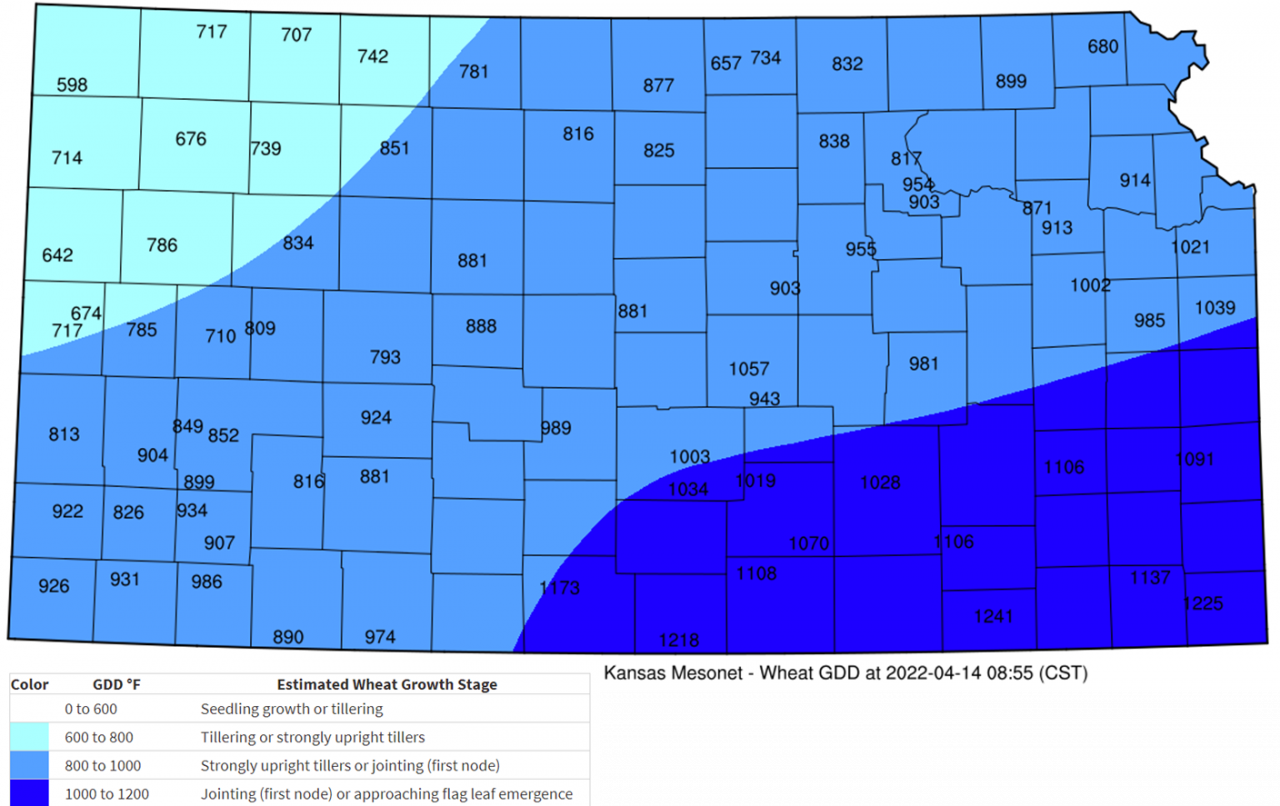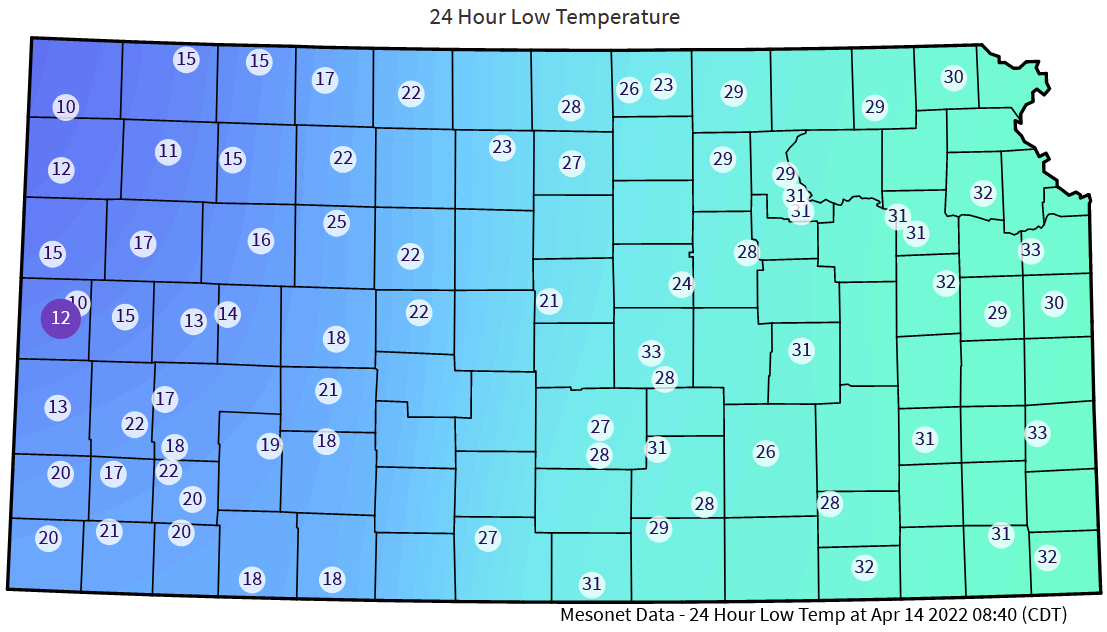Crop conditions
The 2021-22 winter wheat crop in Kansas was off to a good start in the fall, where even precipitation events across the state resulted in good crop establishment. Precipitation events occurred at different timings for western (mid-September) and central (October) Kansas, but these predominantly matched good planting timings for these regions. Consequently, more than 60% of the winter wheat crop was rated as good or excellent by the USDA-NASS during the fall (Fig. 1).
The crop also had above-average temperature conditions during the fall (Fig. 2), which led to good biomass production where water was available from earlier rainfalls (Fig. 3). However, this large biomass production also increased the water consumption by the crop. During the winter and spring, temperatures were below average (Fig. 2), leading to a slowdown of crop growth development. Currently the crop growth stages range from upright tillers in northwest Kansas to the jointing in south-central and southeast Kansas (Fig. 3). The increased water demand led by greater fall biomass production was, unfortunately, met with below average precipitation during the remainder of the fall and during winter – especially in western Kansas (see section below), leading the crop to experience early signs of drought stress in that portion of the state. While the crop in central Kansas is still mostly not undergoing severe drought stress, the recent increase in biomass as the crop goes into reproductive development will be accompanied by an increase in crop water demand; thus, more precipitation will be needed shortly to avoid yield losses due to drought. Consequently, crop conditions deteriorated considerably during the last few months, and the latest USDA-NASS report suggests that only around 30% of the Kansas wheat crop is in good or excellent conditions.

Figure 1. Crop progress report for the 2021-22 winter wheat crop in Kansas. Source: https://www.nass.usda.gov/Charts_and_Maps/Crop_Progress_&_Condition/2022/KS_2022.pdf

Figure 2. Mean monthly average temperatures for Kansas reflecting the wheat season for 2021-22 (orange dots), normal (black line), minimum (blue line) and maximum (red line).

Figure 3. (A) Good biomass production of a September-planted winter wheat field near Hutchinson in a photo taken in mid-December 2021. (B) Winter wheat field experiment planted late after soybeans near Great Bend, reaching the jointing growth stage on 13 April 2022. (C) Winter wheat planted at the optimum time (mid-October) after a previous canola crop, reaching the second node stage of development near Hutchinson on 12 April 2022. (D) Late-October planted winter wheat, no-tilled into soybean stubble, reaching the first node stage of development as of 12 April 2022 near Hutchinson.
Potential for freeze injury during 31 March – 14 April
Cold air temperatures occurred during 31 March – 14 April 2022, which have potential to cause freeze injury to the 2022 Kansas wheat crop. Factors that influence the potential for freeze injury to wheat include primarily:
- Growth stage of the crop.
- Air temperatures.
- Duration of cold temperatures.
- Soil temperatures.
- Snow cover.
Other factors, such as position in the landscape and presence of residue covering the soil surface, might also impact the extent of freeze damage within a field. The challenge is to integrate all these factors into a reasonable estimate of freeze injury.
Wheat growth stage around Kansas
Based on simple wheat development models, the wheat growth stage around Kansas ranges from upright tillers in the northwest to the early jointing stage in central Kansas to later jointing and reaching flag leaf emergence in south-central and southeast Kansas (Figure 4). For fields that have not jointed yet, the crop generally withstands temperatures of 15-20 degrees F fairly well, especially if the growing point is still below ground, which might be the case for some late-planted wheat fields in north-central and northwest Kansas. Kansas Mesonet data indicates that temperatures fell below this threshold, reaching as low as about 10 degrees Fahrenheit in parts of northwest Kansas (Fig. 5), suggesting that some injury could be sustained.
If the growing point is already above ground (first joint visible), wheat can sustain temperatures down to about 24 degrees F for a few hours. Minimum temperatures below 24 degrees F for extended periods of time increase the risk of crop injury. Information from the K-State Mesonet indicates that air temperatures were around this 24-degree F threshold in most of central and north-central Kansas; however, they dipped below the threshold for as many as 7 hours in southwest Kansas (Fig. 5), which can cause damage to fields at the first node of development or more advanced stages.
More advanced fields, such as second node to flag leaf emergence (south-central and southeast Kansas), are more vulnerable to freeze injury, as temperatures near the 24-28 degrees F threshold can cause injury. Minimum temperatures dipped around these sensitive thresholds in those parts of the state, but overall they never reached below 24 degrees F and were below 32 degrees F for no more than 2-4 hours (Fig. 5).

Figure 4. Estimated wheat growth stage as of April 14, 2022. Growth stage is estimated for each county based on temperatures accumulated in the season. Local growth stage may vary with planting date and variety. The KSU Wheat GDD Growth Stage model is available at: https://mesonet.k-state.edu/agriculture/wheat/gdd/



Figure 5. Minimum temperatures observed during the 31 March – 14 April period (upper panel), number of hours below 24 (middle panel) and 32 (lower panel) degrees F observed during the coldest event during the specified period.
Soil temperatures
Soil temperatures can help buffer freezing air temperatures if the growing point is below ground or near the soil surface. However, its buffering capacity decreases as the crop develops and the growing point moves above the soil surface. Thus, we can expect a positive effect from soil temperatures in north central and northwest Kansas where soil temperatures were above 38 degrees during the entire week and the crop is around the first node stage of development. However, the more advanced crop in south central and southeast Kansas, with the growing point further above the soil surface, likely did not benefit as much from the soil temperature buffering capacity.
Integrated risk of freeze injury to Kansas wheat
Based on the factors above, we estimate that parts of southwest Kansas would be more exposed to potential of freeze damage, given that the crop is relatively advanced and was met with many hours of air temperatures below 24 degrees F. This area of high risk corresponds to (i) areas with more hours below threshold for the predominant crop growth stage, and (ii) a more advanced crop development with temperatures at or below the threshold for freeze damage for the corresponding stage. In the remainder of the state, temperatures needed to cause damage at the observed crop stages were borderline and therefore, we expect that only more advanced fields could sustain freeze damage.
Symptoms of freeze injury on foliage should occur over the next few days across the entire state. In most cases, however, leaf burn injury by itself should not result in any long-term damage to the crop, especially if there is available moisture to help the crop recover the lost foliage. Freeze injury symptoms to the developing wheat head, such as a mushy discolored/brown head, take slightly longer to be visible (10-14 days). Thus, growers with fields at advanced growth stages should check for potential injury to the developing head within this timeframe. For more advanced fields, other symptoms to look for include a yellow flag leaf as it emerges from the whorl (which would indicate a dead tiller) and wheat heads that are trapped within the boot and thus emerge from the side of the culm.
Romulo Lollato, Wheat and Forage Specialist
Chip Redmond, Kansas Mesonet Manager
Erick DeWolf, Wheat Pathologist
Kelsey Andersen Onofre, Extension Wheat Pathologist
Tags: wheat freeze injury Condition